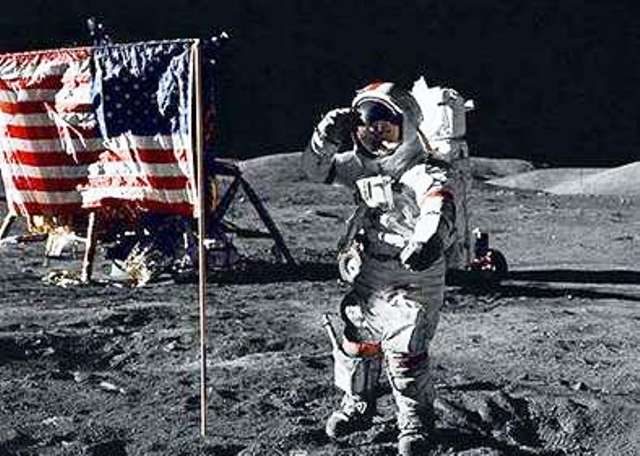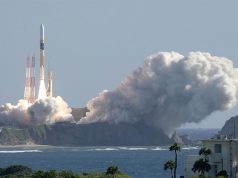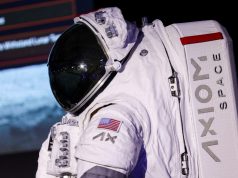BEIJING, CHINA | Back in 1969, Neil Armstrong, the first person to walk on the moon, uttered his famous words: “That’s one small step for (a) man, one giant leap for mankind”.
The statement has inspired ever since. More than 500 astronauts have entered space in the nearly five decades that have followed, and over 10 have landed on the moon.
Buzz Aldrin, the second man to set foot on the moon and Armstrong’s companion in the Apollo 11 mission, gave a presentation on his ideas for visiting Mars at the Global Space Exploration Conference (GLEX 2017), which concluded on Thursday.
What is the next stop?
Global leaders in space exploration have now set their sights on Mars, including China.
Wu Yanhua, deputy head of the China National Space Administration (CNSA), said that the country has started an unmanned Mars probe project and plans to launch a Mars probe around 2020.
Steve Eisenhart, senior vice president of the Strategic and International Affairs of the Space Foundation of the United States, said that Aldrin has been working on his idea for close to 30 years.
According to Aldrin’s plan, humans may be able to land on Mars before 2039 and set up a station there. Eisenhart and Aldrin, while not representing the U.S. government or the National Aeronautics and Space Administration (NASA), agreed that Mars is a good destination for space exploration.
However, Jan Woerner, director-general of European Space Agency (ESA), said that the moon is a good stepping-stone before going to Mars.
“If we have a goal which is too far away, there might be roads in between those inspirations,” said Woerner, adding that the moon is close enough to test and develop needed technology. “It’s a very good test bed — then go deeper into our solar system.”
Tian Yulong, secretary-general of the CNSA, said that China is now in discussions with the ESA on co-building a “moon village.”
Tian said that a house on the moon could be constructed within a week with materials brought from Earth as well as moon surface materials using 3D printing technology.
Yasuyuki Ito, associate director-general of the Japan Aerospace Exploration Agency, said that his generation was greatly affected by the Apollo program.
“Lunar exploration is our target. At the same time, we’ve also been discussing a Mars goal,” he added.
Pascale Ehrenfreund, chair of the executive board of the German Aerospace Center, said that bringing humans to Mars is very difficult, as is raising funds for space exploration.
“We do things in steps. And the moon is one of the important steps on our way to Mars,” she said.
China’s lunar exploration
China’s Chang’e lunar program, named after a legendary goddess, includes three phases: orbiting, landing and returning with samples.
Liu Jizhong, director of the China Lunar Exploration and Space Engineering Center of the CNSA, said the Chang’e 5 lunar probe is expected to land in the Mons Rumker region and to take samples back to Earth at the end of the year.
The probe landing site, an isolated volcanic formation located on the northwest of the near side of the moon.
“China is planning and designing its future lunar exploration program. We will focus on the south pole region of the moon. The research on water and the permanent shadow area of the lunar south pole region will bring greater scientific discoveries,” Liu said.
According to Wu Yansheng, general manager of China Aerospace Science and Technology Corporation (CASC), China is working on an idea for manned lunar landing.
The mission will consist of a manned spaceship, a propulsion vehicle and a lunar lander. The manned spaceship and the lunar lander will be sent into circumlunar orbit separately.
Yang Liwei, deputy director of the China Manned Space Engineering Office, said that China is in the preliminary stage of its manned lunar program and estimated that Chinese astronauts will be able to walk on the moon around 2030.
Low-cost space transport
Without capable launch vehicles, humans are not able to go deeper into space.
China’s Long March carrier rockets still have room for improvement, according to Lu Yu, director of Science and Technology Committee of the China Academy of Launch Vehicle Technology (CALT).
He said that CALT is developing a heavy-lift launch vehicle with a payload of 140 tonnes to low Earth orbit and 50 tonnes to lunar transfer orbit.
CALT has made progress in developing reusable launch vehicles, including parachute landing and propulsion landing, said Lu.
Founded by U.S. entrepreneur Elon Musk in 2002, SpaceX aims to reduce space transportation costs and enable the colonization of Mars. It has developed the Falcon launch vehicle family and invested big in reusable technology for orbital rockets.
Aerospace transportation is now focused on low-cost ways to enter space, said Wang Guoqing, a CASC official.
Wang said leaders in space exploration have set up their own range of launch vehicles and systems, and reusing launch vehicles will become important for reducing costs.
“Breakthroughs have been achieved in reusable technology after 10 years of study. However, we still face challenges as reusable aerospace launches require high reliability and safety,” he added.
Win-win situation
Chinese and global space leaders reached an agreement on cooperation in space exploration at GLEX 2017 — no matter whether they aim for the moon or Mars.
“China is expanding cooperation with the United Nations (UN) in space exploration and will disclose projects later this year,” said Yang.
The country has previously undertaken bilateral cooperation with various countries and institutions and is looking toward multilateral projects. China will carry out joint projects with the UN Office of Outer Space Affairs (UNOOSA), including astronaut training, scientific experiments aboard space stations and multilateral application of such experiments, he added.
Liu also proposed creating an open platform for cooperation in accordance with the principle of “sharing the risks and achievements” and setting up the International Union of Planetary Scientists and the International Union of Planetary Science College Students.
“Rather than a space race, I think cooperation is always good and worldwide cooperation is even better. I hope we can breach Earth’s crises by having worldwide cooperation in space,” said Woerner.
“We should not try to duplicate everything, and if we join forces we can do even more with the same amount of money,” he added.










